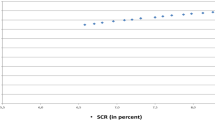Abstract
We study a utility maximization problem under multiple Value-at-Risk (VaR)-type constraints. The optimization framework is particularly important for financial institutions which have to follow short-time VaR-type regulations under some realistic regulatory frameworks like Solvency II, but need to serve long-term liabilities. Deriving closed-form solutions, we show that risk management using multiple VaR constraints is more useful for loss prevention at intertemporal time instances compared with the well-known result of the one-VaR problem in Basak and Shapiro (Rev Financ Stud 14:371–405, 2001), confirming the numerical analysis of Shi and Werker (J Bank Finance 36(12):3227–3238, 2012). In addition, the multiple-VaR solution at maturity on average dominates the one-VaR solution in a wide range of intermediate market scenarios, but performs worse in good and very bad market scenarios. The range of these very bad market scenarios is however rather limited. Finally, we show that it is preferable to reach a fixed terminal state through insured intertemporal states rather than through extreme up and down movements, showing that a multiple-VaR framework induces a preference for less volatility.







Similar content being viewed by others
Notes
For instance, according to Solvency II, the solvency capital requirement for the insurance companies is based on an annual VaR-measure calibrated to a 99.5% confidence level (c.f. Article 100 of Solvency II directive).
While finishing this paper we found out that the problem of an one-VaR constraint with possible stochastic liability level \(L_T\) has been considered in Boyle and Tian (2007). We would like to thank Monique Jeanblanc for pointing out this important reference.
References
Alexander GJ, Baptista AM, Yan S (2012) When more is less: using multiple constraints to reduce tail risk. J Bank Finance 36(10):2693–2716
Basak S, Shapiro A (2001) Value-at-risk-based risk management: optimal policies and asset prices. Rev Financ Stud 14:371–405
Basak S, Shapiro A, Teplá L (2006) Risk management with benchmarking. Manag Sci 52(4):542–557
Boyle P, Tian W (2007) Portfolio management with constraints. Math Finance 17(3):319–343
Chen A, Nguyen T, Stadje M (2018) Optimal investment under var-regulation and minimum insurance. Insur Math Econ 79:194–209
Cuoco D (1997) Optimal consumption and equilibrium prices with portfolio constraints and stochastic income. J Econ Theory 71(1):33–73
Cuoco D, He H, Issaenko S (2008) Optimal dynamic trading strategies with risk limits. Oper Res 56:358–368
Cuoco D, Liu H (2006) An analysis of var-based capital requirements. J Financ Intermed 15(3):362–394
Cvitanic J, Karatzas I (1992) Convex duality in constrained portfolio optimization. Ann Appl Probab 2(4):767–818
Gandy R (2005) Portfolio optimization with risk constraints. PhD thesis, University of Ulm
Grossman SJ, Zhou Z (1996) Equilibrium analysis of portfolio insurance. J Finance 51(4):1379–1403
Gundel A, Weber S (2008) Utility maximization under a shortfall risk constraint. J Math Econ 44(11):1126–1151
Jang BG, Park S (2016) Ambiguity and optimal portfolio choice with value-at-risk constraint. Finance Res Lett 18((Supplement C)):158–176
Kraft H, Steffensen M (2013) A dynamic programming approach to constrained portfolios. Eur J Oper Res 229(2):453–461
MacLean LC, Zhao Y, Ziemba WT (2016) Optimal capital growth with convex shortfall penalties. Quant Finance 16(1):101–117
Santos AAP, Nogales FJ, Ruiz E, Dijk DV (2012) Optimal portfolios with minimum capital requirements. J Bank Finance 36(7):1928–1942
Sass J, Wunderlich R (2010) Optimal portfolio policies under bounded expected loss and partial information. Math Methods Oper Res 72(1):25–61
Schyns M, Crama Y, Hübner G (2010) Optimal selection of a portfolio of options under value-at-risk constraints: a scenario approach. Ann Oper Res 181(1):683–708
Shi Z, Werker JMB (2012) Short-horizon regulation for long-term investors. J Bank Finance 36(12):3227–3238
Xu L, Gao C, Kou G, Liu Q (2017) Comonotonic approximation to periodic investment problems under stochastic drift. Eur J Oper Res 262(1):251–261
Yiu KFC (2004) Optimal portfolios under a value-at-risk constraint. J Econ Dyn Control 28(7):1317–1334
Author information
Authors and Affiliations
Corresponding author
Rights and permissions
About this article
Cite this article
Chen, A., Nguyen, T. & Stadje, M. Risk management with multiple VaR constraints. Math Meth Oper Res 88, 297–337 (2018). https://doi.org/10.1007/s00186-018-0637-1
Received:
Published:
Issue Date:
DOI: https://doi.org/10.1007/s00186-018-0637-1




